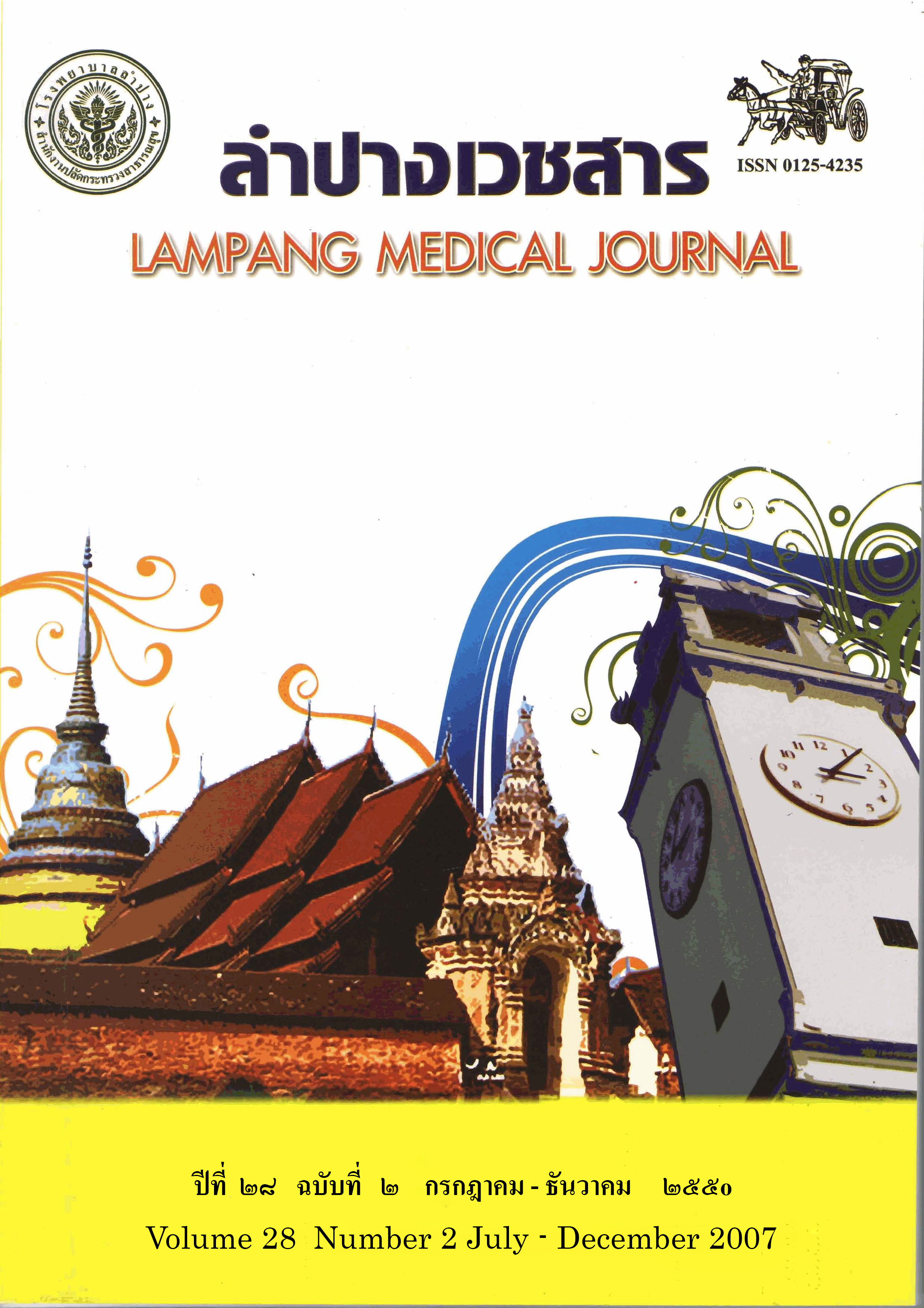Vertical Transmission Rate of HIV in Chiang Rai Regional Hospital
Main Article Content
Abstract
Background :
Vertical transmission rate of HIV was reduced from 42 percent to 25.2 percent by replacement formula-feeding. Zidovudine (AZT) prophylaxis starting at 28 weeks gestation and single dose of nevirapine (NVP) to mothors and infants decreased the rate of transmission to 1.9 percent. Vertical transmission rate reflects the outcome of antenatal and infant care.
Objective:
To study vertical transmission rate of HIV in Chiang Rai Reginal Hospital and to evaluate the results of AZT prophylaxis according to duration before delivery.
Method:
We conducted a retrospective cohort study by collection data of HIVseropositive pregnant women and infants diliveried during January 1, 2004 to December 31, 2006 and had follow-up visits at Chiang Rai Regional Hospital. Mothers and infants recieved antiretroviral drugs according to the national program of the Ministry of Public Health.
Results:
A total of 101 cases were enrolled in this study. Fifty-nine mothers (58.4 percent) recieved AZT prophylaxis for 4 weeks or longer. Mothers recieved AZT and NVP at onset of labor 89 cases (88.14 percent) and 85 cases (84.1 percent) respectively. All of infants recieved AZT and 97 cases (96 percent) recieved NVP. Vertical transmission rate of HIV was 5.94 percent (6/101). Duration of AZT
prophylaxis of pregnant women less than 4 weeks was statistically inferior to that of weeks or longer.
Conclusion:
Zidovudine and nevirapine therapy in mother and infants are effective in reducing vertical transmission of HIV especially when mothers recieved aZT for 4 weeks or longer befor delivery.
Article Details

This work is licensed under a Creative Commons Attribution-NonCommercial-NoDerivatives 4.0 International License.
บทความที่ส่งมาลงพิมพ์ต้องไม่เคยพิมพ์หรือกำลังได้รับการพิจารณาตีพิมพ์ในวารสารอื่น เนื้อหาในบทความต้องเป็นผลงานของผู้นิพนธ์เอง ไม่ได้ลอกเลียนหรือตัดทอนจากบทความอื่น โดยไม่ได้รับอนุญาตหรือไม่ได้อ้างอิงอย่างเหมาะสม การแก้ไขหรือให้ข้อมูลเพิ่มเติมแก่กองบรรณาธิการ จะต้องเสร็จสิ้นเป็นที่เรียบร้อยก่อนจะได้รับพิจารณาตีพิมพ์ และบทความที่ตีพิมพ์แล้วเป็นสมบัติ ของลำปางเวชสาร
References
พัชราพร เอ้า, ปรีชา รัตนศิริทรัพย์, รวิวรรณ หาญสุทธิเวชกุล, และคณะ. การศึกษาการติดเชื้อเอชไอวีในเด็กที่คลอดจากมารดาที่ติดเชื้อเอชไอวีในโรงพยาบาลเชียงรายประชานุเคราะห์. วารสารกุมารเวชศาสตร์ 2536;32(3):169-73.
ไกรฤกษ์ ไตรรัตนาภา, ศิริราช พัวพันวัฒนะ, รวิรรณ หาญสุทธิเวชกุล และคณะ. อัตราการติดเชื้อเอชไอวีจากมารดาสู่ทารก ตรวจโดยวิธีโพลิเมอเรสเชนรีแอคชั่นในโรงพยาบาลเชียงรายประชานุเคราะห์. วารสารกุมารเวชศาสตร์ 2540;36(3):179-89.
Reduction of maternal-infant transmission of Human immmunodeficiency virus type 1 with zidovudine treatment. N Eng J Med. 1994;331:1173-80.
Lallemant M, Jourdian G, Le Coeur S, et al. A trial of shortened Zidovudine regimens to prevent mother-to-child transmission of Human Immunodiffiency Virus type 1. N Eng J Med. 2000;343(14):982-91.
รวิวรรณ หาญสุทธิเวชกุล, จุลพงศ์ อจลพงศ์, ศิริราช พัวพันวัฒนะ. การลดอัตราการถ่ายทอดเชื้อเอชไอวีจากมารดาสู่ทารก.
วารสารกุมารเวชศาสตร์. 2544;40(4):261-7.
Lallemant M, Jourdin G, Le Coeur S, et al. Single-dose perinatal Nevirapine plus Standard Zidovudine to Prevent Mother-to-Child Transmission of HIV-1 in Thailand. N Eng J Med. 2004;351:217-28.
Centers for Disease Control and Prevention. Guidelines for national human immunodeficiency virus care surviellance, including mornitoring for human immunodeficiency virus infection and acquired immunodefidiency syndrome,
MMWR Recomm Rep. 1999;48(RR-13):1-28.
Centers for Disease Control and Prevention, 1994 revised classification system for HIV infection in children less than 13 years of age.
Official authorized addenda : Human immunodeficiency virus infection codes and official guidelines for coding and reporting
ICD-9-CM. MMWR Recomm Rep. 1994;43(RR-1):1-19.
Grace C John-Stewart. When is replacement feeding safe for infants of HIV-infected women. PLoS Med. 2007;4(1):e30.
Thior I, Lockman S, Smeaton LM, et al. Breastfeeding plus infant zidovudine prophylaxis for 6 months vs formula feeding plus infant zidovudine for 1 month to reduce mother-to-child HIV transmission in Botswana : a randomized trial : the Mashi study. JAMA. 2006;16:296(7):794-805.
The International Perinatal HIV Group. The mode of delivery and the risk of verical transmission of human immunodeficiency virus type I. N Eng J Med. 1999;340:977-87.
Trinh Duong, statistician, Ade AE, Diana M Gibb, et al. Vertical transmission rates for HIV in the British Iseles : estimates based on surviellance data. BMJ. 1999;319(7219):1227-9.
Mills EJ, Wu P, Seely D, et al. Vitamin supplementation for prevention of mother-to-child transmission of HIV and pre-term delivery : a systematic review of randomized trial including more than 2800 women. AIDS Res Ther. 2005;2:4.
Gorny MK, Zollar-Pazner S, Immunoprophylaxis againt mother-to-child transmission of HIV-1. PLoS Med. 2006;3(7):e259.
Mrus JM, Tsevat J. Cost-effectiveness of interventions from pregnant who have not recieved prenatal care. Med Decis Making. 2004;24(1):30-9.
Teerawattananon Y, Vos T, Tangcharoensathien V, et al. Cost-effectiveness od models for prevention of vertical HIV transmission voluntary counseling and testing and choices of drug regimen. Cost Resour Alloc. 2007;3:7.
Une traduction francaise integrale de la declaration suit cet article. Reduction of HIV transmission from mother to infant. CMAJ. 1994;151(5):583-8.
Taha TE, Kumwenda NI, Hoover DR, et al. Nevirapine and zidovudine at birth to reduce perinatal transmission of HIV in an African setting : a randomized controlled trial. JAMA. 2004;292(2):202-9.
Volmink J, Siegfried NL, Can der Merwe L, et al. Antiretrovirals for reducing the risk of mether-to-child transmission of HIV infection. Cochrane Database Syst Rev. 2007;(1):CD003510.
Gottieb S. Pregnant women with HIV should be started on antiretroviral drugs no later than 28 weeks. BMJ. 2000;321(7266):915.
Nelly Briand, Lallemant M, Jourdain G, et al. Hematological safety of perinatal Zidovudine in pregnant HIV-1-infected women in Thailand : Secondary analysis of a randomized trial. PLoS Clin Trials. 2007;2(4):e11.


